BSc Management BMP3004: Functional Areas & Skills Analysis
VerifiedAdded on 2023/06/08
|8
|2009
|86
Report
AI Summary
This report provides a comprehensive overview of the functional areas within a business, including marketing, human resource management, customer service, finance, research and development, and sales. It defines each area, outlines its key functions, and describes the skills required for employees to work effectively in each department. The report emphasizes the importance of understanding these functional areas for effective business management and planning. It also touches upon the significance of pre-planning and the potential consequences of neglecting essential organizational aspects. The document concludes by summarizing the key takeaways and referencing relevant academic sources. Desklib offers a platform to access this and other solved assignments for students.
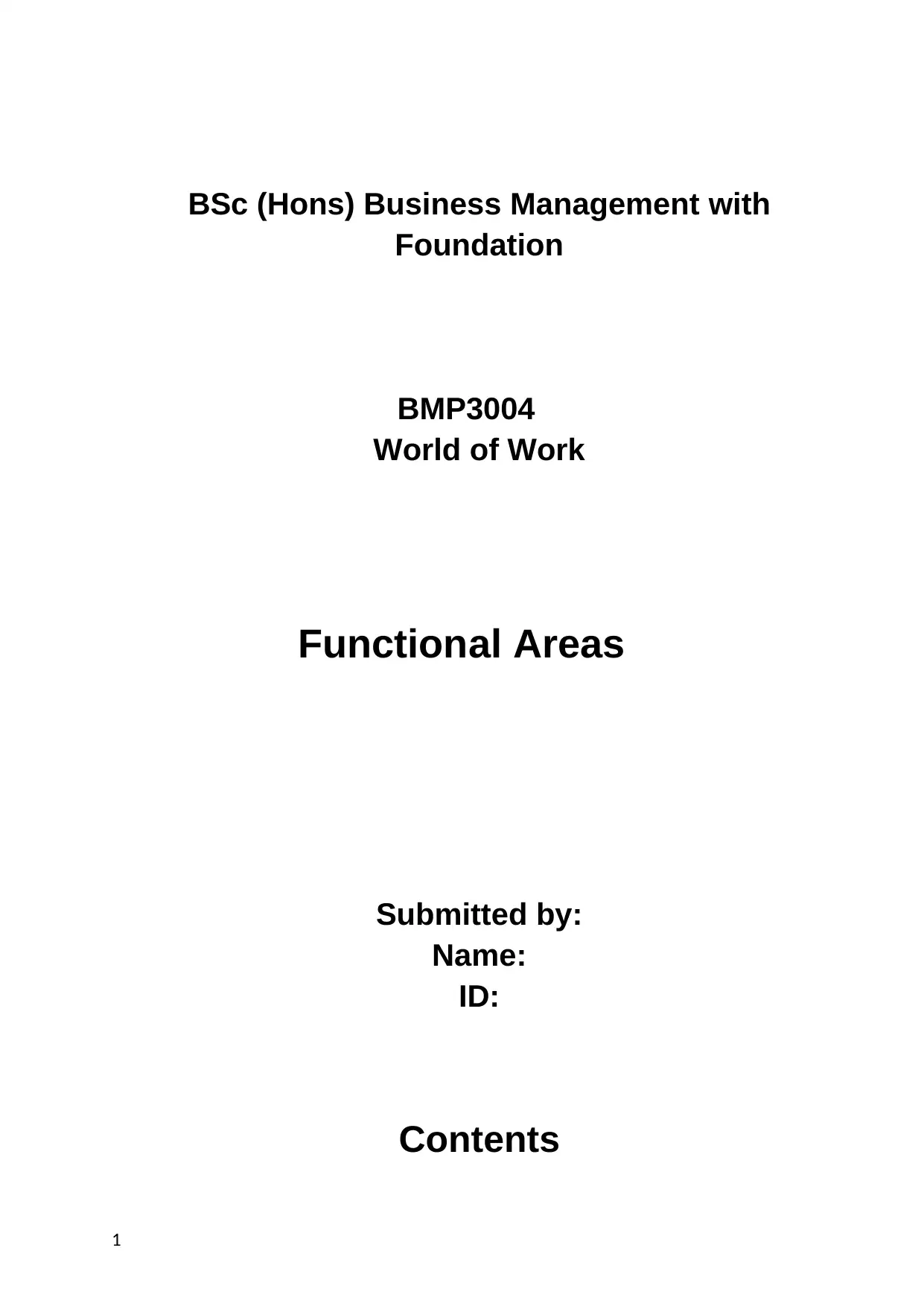
BSc (Hons) Business Management with
Foundation
BMP3004
World of Work
Functional Areas
Submitted by:
Name:
ID:
Contents
1
Foundation
BMP3004
World of Work
Functional Areas
Submitted by:
Name:
ID:
Contents
1
Paraphrase This Document
Need a fresh take? Get an instant paraphrase of this document with our AI Paraphraser
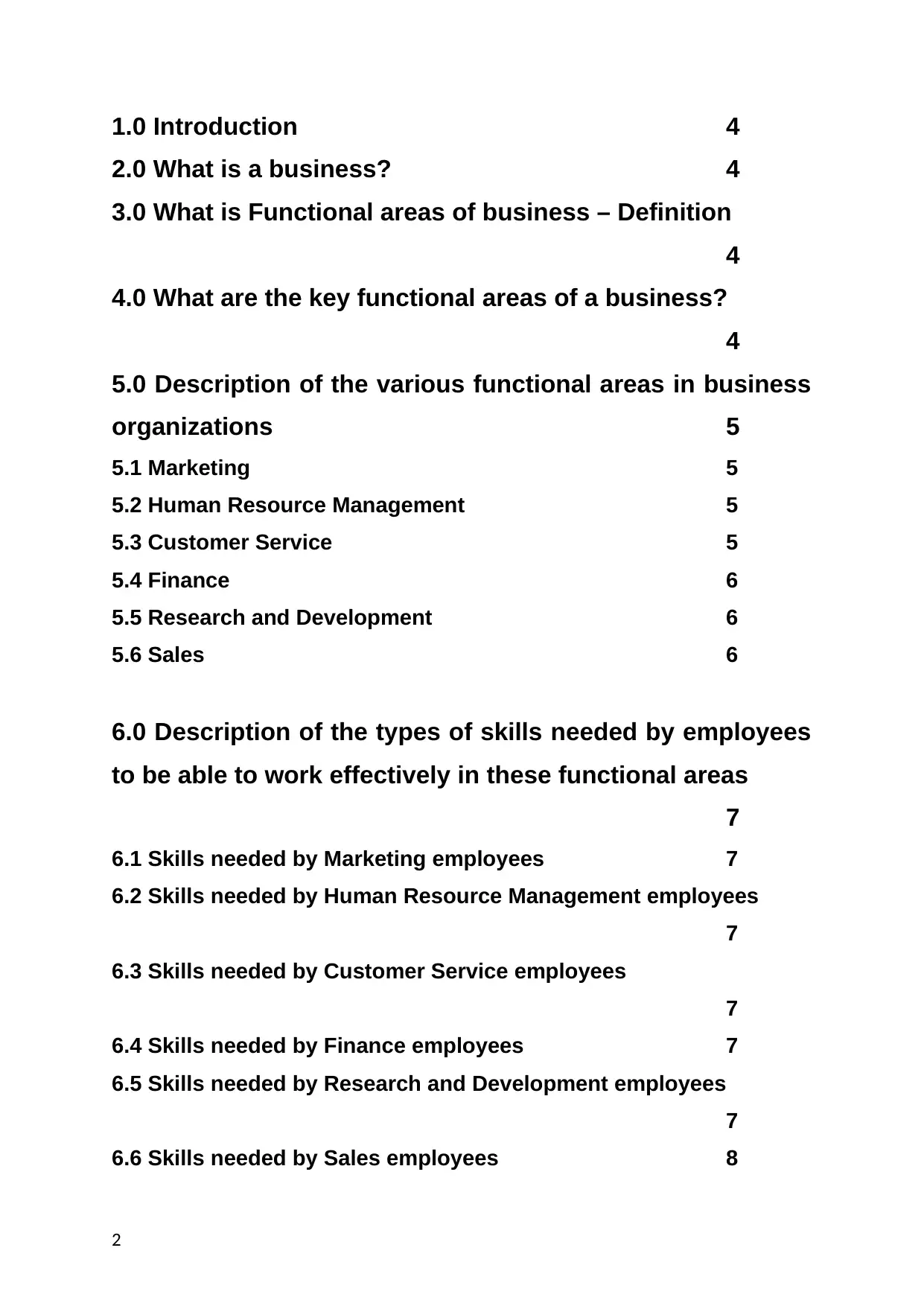
1.0 Introduction 4
2.0 What is a business? 4
3.0 What is Functional areas of business – Definition
4
4.0 What are the key functional areas of a business?
4
5.0 Description of the various functional areas in business
organizations 5
5.1 Marketing 5
5.2 Human Resource Management 5
5.3 Customer Service 5
5.4 Finance 6
5.5 Research and Development 6
5.6 Sales 6
6.0 Description of the types of skills needed by employees
to be able to work effectively in these functional areas
7
6.1 Skills needed by Marketing employees 7
6.2 Skills needed by Human Resource Management employees
7
6.3 Skills needed by Customer Service employees
7
6.4 Skills needed by Finance employees 7
6.5 Skills needed by Research and Development employees
7
6.6 Skills needed by Sales employees 8
2
2.0 What is a business? 4
3.0 What is Functional areas of business – Definition
4
4.0 What are the key functional areas of a business?
4
5.0 Description of the various functional areas in business
organizations 5
5.1 Marketing 5
5.2 Human Resource Management 5
5.3 Customer Service 5
5.4 Finance 6
5.5 Research and Development 6
5.6 Sales 6
6.0 Description of the types of skills needed by employees
to be able to work effectively in these functional areas
7
6.1 Skills needed by Marketing employees 7
6.2 Skills needed by Human Resource Management employees
7
6.3 Skills needed by Customer Service employees
7
6.4 Skills needed by Finance employees 7
6.5 Skills needed by Research and Development employees
7
6.6 Skills needed by Sales employees 8
2

7.0 Conclusion 8
References 8
3
References 8
3
⊘ This is a preview!⊘
Do you want full access?
Subscribe today to unlock all pages.

Trusted by 1+ million students worldwide
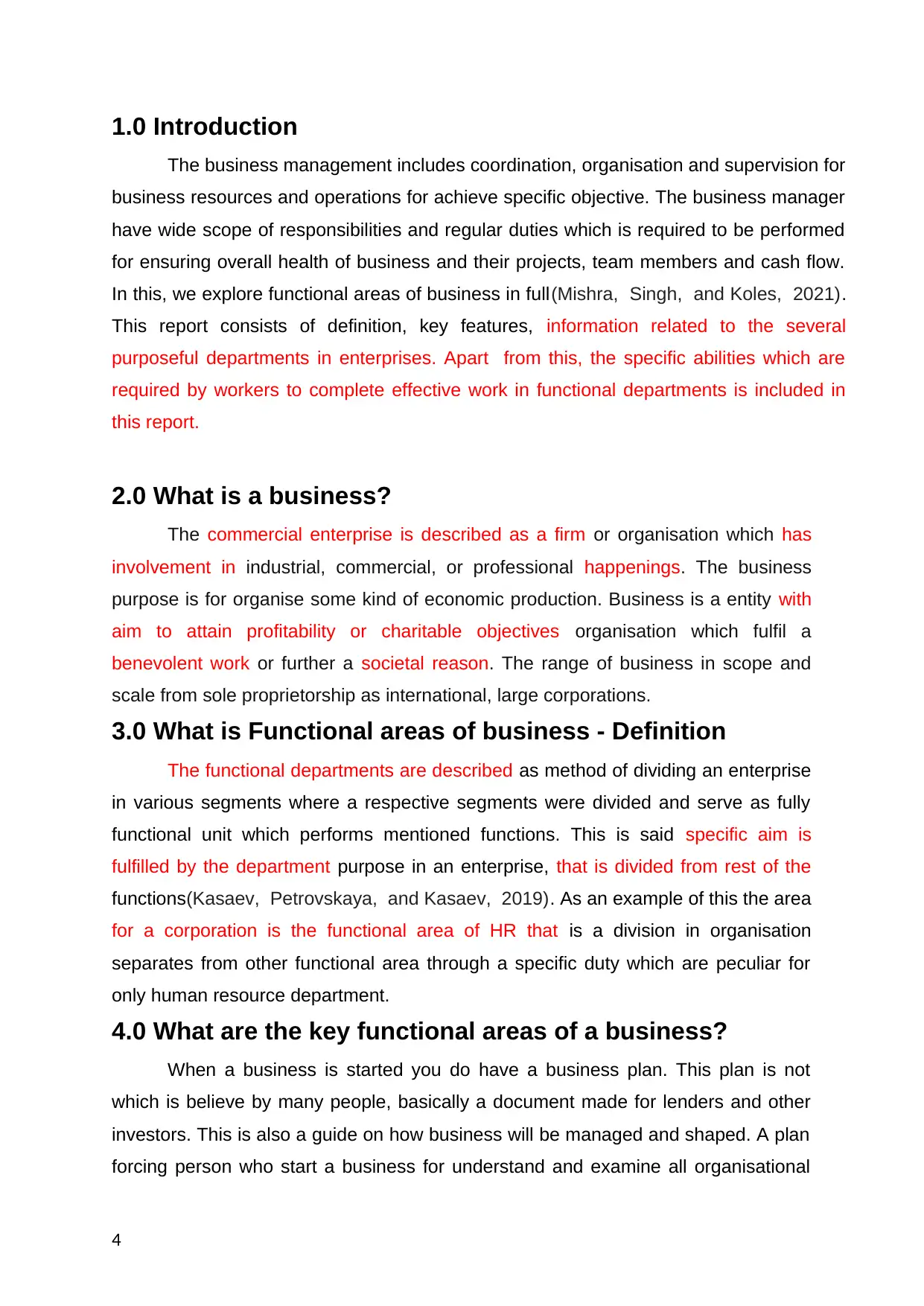
1.0 Introduction
The business management includes coordination, organisation and supervision for
business resources and operations for achieve specific objective. The business manager
have wide scope of responsibilities and regular duties which is required to be performed
for ensuring overall health of business and their projects, team members and cash flow.
In this, we explore functional areas of business in full(Mishra, Singh, and Koles, 2021).
This report consists of definition, key features, information related to the several
purposeful departments in enterprises. Apart from this, the specific abilities which are
required by workers to complete effective work in functional departments is included in
this report.
2.0 What is a business?
The commercial enterprise is described as a firm or organisation which has
involvement in industrial, commercial, or professional happenings. The business
purpose is for organise some kind of economic production. Business is a entity with
aim to attain profitability or charitable objectives organisation which fulfil a
benevolent work or further a societal reason. The range of business in scope and
scale from sole proprietorship as international, large corporations.
3.0 What is Functional areas of business - Definition
The functional departments are described as method of dividing an enterprise
in various segments where a respective segments were divided and serve as fully
functional unit which performs mentioned functions. This is said specific aim is
fulfilled by the department purpose in an enterprise, that is divided from rest of the
functions(Kasaev, Petrovskaya, and Kasaev, 2019). As an example of this the area
for a corporation is the functional area of HR that is a division in organisation
separates from other functional area through a specific duty which are peculiar for
only human resource department.
4.0 What are the key functional areas of a business?
When a business is started you do have a business plan. This plan is not
which is believe by many people, basically a document made for lenders and other
investors. This is also a guide on how business will be managed and shaped. A plan
forcing person who start a business for understand and examine all organisational
4
The business management includes coordination, organisation and supervision for
business resources and operations for achieve specific objective. The business manager
have wide scope of responsibilities and regular duties which is required to be performed
for ensuring overall health of business and their projects, team members and cash flow.
In this, we explore functional areas of business in full(Mishra, Singh, and Koles, 2021).
This report consists of definition, key features, information related to the several
purposeful departments in enterprises. Apart from this, the specific abilities which are
required by workers to complete effective work in functional departments is included in
this report.
2.0 What is a business?
The commercial enterprise is described as a firm or organisation which has
involvement in industrial, commercial, or professional happenings. The business
purpose is for organise some kind of economic production. Business is a entity with
aim to attain profitability or charitable objectives organisation which fulfil a
benevolent work or further a societal reason. The range of business in scope and
scale from sole proprietorship as international, large corporations.
3.0 What is Functional areas of business - Definition
The functional departments are described as method of dividing an enterprise
in various segments where a respective segments were divided and serve as fully
functional unit which performs mentioned functions. This is said specific aim is
fulfilled by the department purpose in an enterprise, that is divided from rest of the
functions(Kasaev, Petrovskaya, and Kasaev, 2019). As an example of this the area
for a corporation is the functional area of HR that is a division in organisation
separates from other functional area through a specific duty which are peculiar for
only human resource department.
4.0 What are the key functional areas of a business?
When a business is started you do have a business plan. This plan is not
which is believe by many people, basically a document made for lenders and other
investors. This is also a guide on how business will be managed and shaped. A plan
forcing person who start a business for understand and examine all organisational
4
Paraphrase This Document
Need a fresh take? Get an instant paraphrase of this document with our AI Paraphraser

aspects and running it, so this is an essential tool for management. Many new
operator of business caught in euphoric atmosphere to make their own business
avoid these essential pre-planning as this is not as exciting as selling or devising a
product service. Furthermore, approx 80% of business fails in five years, largely as
they were not well managed and planned, great pre-planning increase the chance of
success. Usually, there is six functional area for management of business includes
marketing, strategy, human resources, finance, equipment and technology, and
operations. All the planners of business have concentrate on thoroughly and
understand these area as this is related to individual business.
5.0 Description of the various functional areas in business
organizations
5.1 Marketing:
It is essential area for a firm because it is needed to heighten sales and
achieve strong consumer base. The aim of marketing functional area is to help
the firm effectively promote their brand and attract large number of
consumers. It is done to increase the total revenue and maximize brand reach
in operating regions of the company. Marketing objectives are achieved by the
marketing department through variety of ways such as advertisements, social
media campaigns, digital marketing consumer relationship and PR.
5.2 Human Resource Management:
The department of managing workforce also referred to as human resource
management is required to be consider at time of planning for organisation.
Increasing of attention is needed as development of human resource. These are
given priority. To start new venture or expansion of plant the top management
considers human resource requirement. The type of quality and number for human
resources is to consider and decision taken accordingly. The method for appraisal,
procurement structure of salary and other benefit for health, reward and safety
provisions are for decide and plan at time of planning for organisation.
5.3 Customer Service:
The customer service is referred as the assistance of an organization offers to
their customers after or before they use or buy services or products(Jakubowski,
5
operator of business caught in euphoric atmosphere to make their own business
avoid these essential pre-planning as this is not as exciting as selling or devising a
product service. Furthermore, approx 80% of business fails in five years, largely as
they were not well managed and planned, great pre-planning increase the chance of
success. Usually, there is six functional area for management of business includes
marketing, strategy, human resources, finance, equipment and technology, and
operations. All the planners of business have concentrate on thoroughly and
understand these area as this is related to individual business.
5.0 Description of the various functional areas in business
organizations
5.1 Marketing:
It is essential area for a firm because it is needed to heighten sales and
achieve strong consumer base. The aim of marketing functional area is to help
the firm effectively promote their brand and attract large number of
consumers. It is done to increase the total revenue and maximize brand reach
in operating regions of the company. Marketing objectives are achieved by the
marketing department through variety of ways such as advertisements, social
media campaigns, digital marketing consumer relationship and PR.
5.2 Human Resource Management:
The department of managing workforce also referred to as human resource
management is required to be consider at time of planning for organisation.
Increasing of attention is needed as development of human resource. These are
given priority. To start new venture or expansion of plant the top management
considers human resource requirement. The type of quality and number for human
resources is to consider and decision taken accordingly. The method for appraisal,
procurement structure of salary and other benefit for health, reward and safety
provisions are for decide and plan at time of planning for organisation.
5.3 Customer Service:
The customer service is referred as the assistance of an organization offers to
their customers after or before they use or buy services or products(Jakubowski,
5
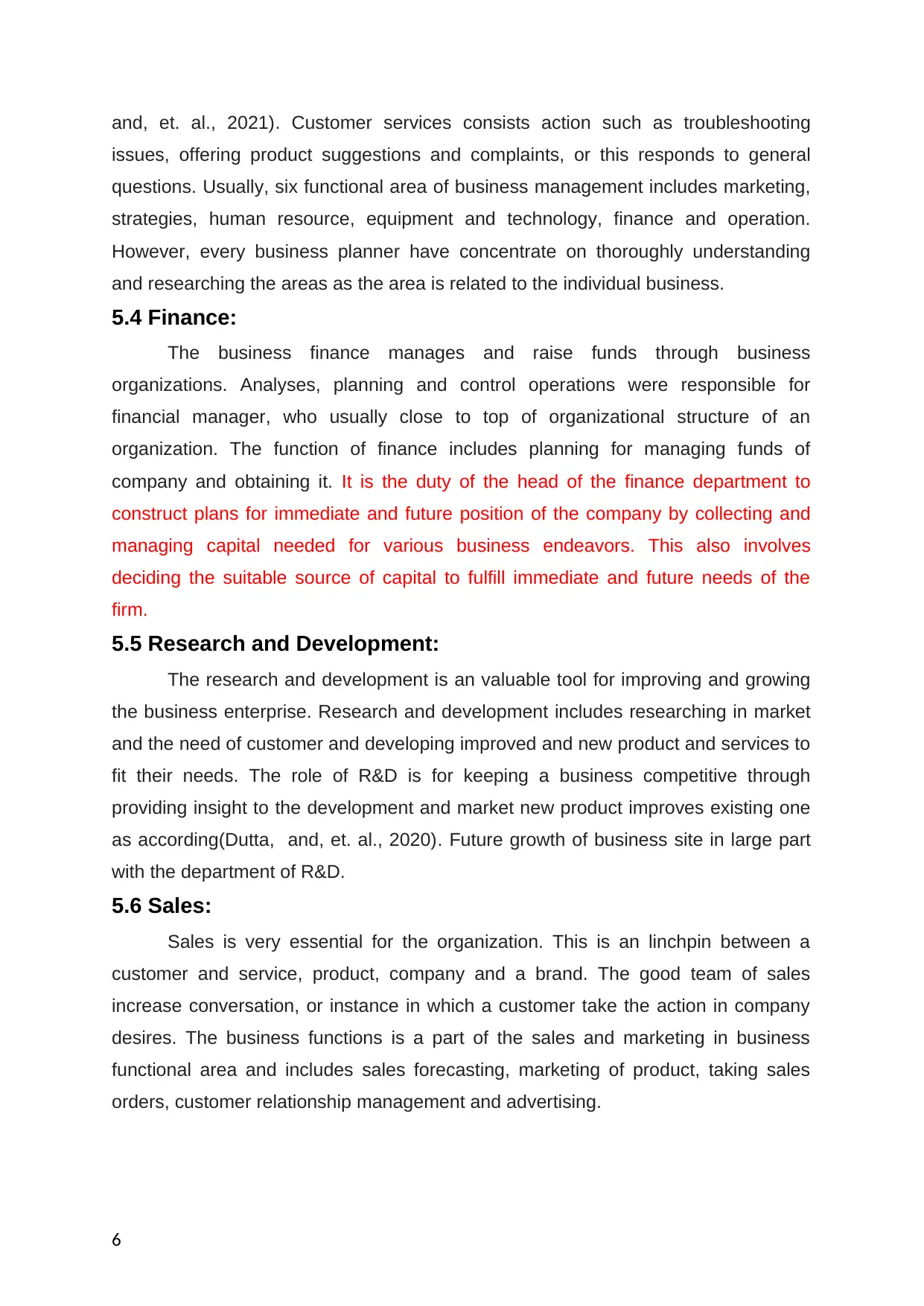
and, et. al., 2021). Customer services consists action such as troubleshooting
issues, offering product suggestions and complaints, or this responds to general
questions. Usually, six functional area of business management includes marketing,
strategies, human resource, equipment and technology, finance and operation.
However, every business planner have concentrate on thoroughly understanding
and researching the areas as the area is related to the individual business.
5.4 Finance:
The business finance manages and raise funds through business
organizations. Analyses, planning and control operations were responsible for
financial manager, who usually close to top of organizational structure of an
organization. The function of finance includes planning for managing funds of
company and obtaining it. It is the duty of the head of the finance department to
construct plans for immediate and future position of the company by collecting and
managing capital needed for various business endeavors. This also involves
deciding the suitable source of capital to fulfill immediate and future needs of the
firm.
5.5 Research and Development:
The research and development is an valuable tool for improving and growing
the business enterprise. Research and development includes researching in market
and the need of customer and developing improved and new product and services to
fit their needs. The role of R&D is for keeping a business competitive through
providing insight to the development and market new product improves existing one
as according(Dutta, and, et. al., 2020). Future growth of business site in large part
with the department of R&D.
5.6 Sales:
Sales is very essential for the organization. This is an linchpin between a
customer and service, product, company and a brand. The good team of sales
increase conversation, or instance in which a customer take the action in company
desires. The business functions is a part of the sales and marketing in business
functional area and includes sales forecasting, marketing of product, taking sales
orders, customer relationship management and advertising.
6
issues, offering product suggestions and complaints, or this responds to general
questions. Usually, six functional area of business management includes marketing,
strategies, human resource, equipment and technology, finance and operation.
However, every business planner have concentrate on thoroughly understanding
and researching the areas as the area is related to the individual business.
5.4 Finance:
The business finance manages and raise funds through business
organizations. Analyses, planning and control operations were responsible for
financial manager, who usually close to top of organizational structure of an
organization. The function of finance includes planning for managing funds of
company and obtaining it. It is the duty of the head of the finance department to
construct plans for immediate and future position of the company by collecting and
managing capital needed for various business endeavors. This also involves
deciding the suitable source of capital to fulfill immediate and future needs of the
firm.
5.5 Research and Development:
The research and development is an valuable tool for improving and growing
the business enterprise. Research and development includes researching in market
and the need of customer and developing improved and new product and services to
fit their needs. The role of R&D is for keeping a business competitive through
providing insight to the development and market new product improves existing one
as according(Dutta, and, et. al., 2020). Future growth of business site in large part
with the department of R&D.
5.6 Sales:
Sales is very essential for the organization. This is an linchpin between a
customer and service, product, company and a brand. The good team of sales
increase conversation, or instance in which a customer take the action in company
desires. The business functions is a part of the sales and marketing in business
functional area and includes sales forecasting, marketing of product, taking sales
orders, customer relationship management and advertising.
6
⊘ This is a preview!⊘
Do you want full access?
Subscribe today to unlock all pages.

Trusted by 1+ million students worldwide

6.0 Description of the types of skills needed by employees
to be able to work effectively in these functional areas
6.1 Skills needed by Marketing employees:
This is meant as being able for identify problems of customers, sometimes
before they do, and find a way to address the problem and needs form the services
and products which is provided. This mainly needs to use two skill areas which are
analytical skill and communication skill(Chell, Hedberg-Jalonen, and Miettinen,
2019).
6.2 Skills needed by Human Resource Management employees:
Most of the Human Resource generalist now needs to be data driven and
analytical. The competencies of the Human resource manager do include the ability
for understand the key Human Resource metric, engagement and retention, such as
recruitment and value of employee and performance. Have the knowledge of Excel
is one of the great advantage.
6.3 Skills needed by Customer Service employees:
The skill of customer service incorporate traits which are empathy, sincerity,
positive attitude and sincerity. This do also have practice and methods which an
organization can teach. This have problem solving skill, clear communication, active
listening and structured follow up.
6.4 Skills needed by Finance employees:
`This is a capability used as relevant understanding and knowledge for
managing unpredictable or an expected situation as to resolving various finance
challenges faced by the company and change it into an exploitative opportunity for
the advantage of the company. In addition to this finance department employees are
also expected to have high level planning and data analysis skills to for financial
management and recording financial data (Castelo-Branco, Cruz-Jesus, and
Oliveira, 2019).
6.5 Skills needed by Research and Development employees:
The Research and development is an essential tool to improvise and grow the
business. Research and development includes researching the market and customer
7
to be able to work effectively in these functional areas
6.1 Skills needed by Marketing employees:
This is meant as being able for identify problems of customers, sometimes
before they do, and find a way to address the problem and needs form the services
and products which is provided. This mainly needs to use two skill areas which are
analytical skill and communication skill(Chell, Hedberg-Jalonen, and Miettinen,
2019).
6.2 Skills needed by Human Resource Management employees:
Most of the Human Resource generalist now needs to be data driven and
analytical. The competencies of the Human resource manager do include the ability
for understand the key Human Resource metric, engagement and retention, such as
recruitment and value of employee and performance. Have the knowledge of Excel
is one of the great advantage.
6.3 Skills needed by Customer Service employees:
The skill of customer service incorporate traits which are empathy, sincerity,
positive attitude and sincerity. This do also have practice and methods which an
organization can teach. This have problem solving skill, clear communication, active
listening and structured follow up.
6.4 Skills needed by Finance employees:
`This is a capability used as relevant understanding and knowledge for
managing unpredictable or an expected situation as to resolving various finance
challenges faced by the company and change it into an exploitative opportunity for
the advantage of the company. In addition to this finance department employees are
also expected to have high level planning and data analysis skills to for financial
management and recording financial data (Castelo-Branco, Cruz-Jesus, and
Oliveira, 2019).
6.5 Skills needed by Research and Development employees:
The Research and development is an essential tool to improvise and grow the
business. Research and development includes researching the market and customer
7
Paraphrase This Document
Need a fresh take? Get an instant paraphrase of this document with our AI Paraphraser
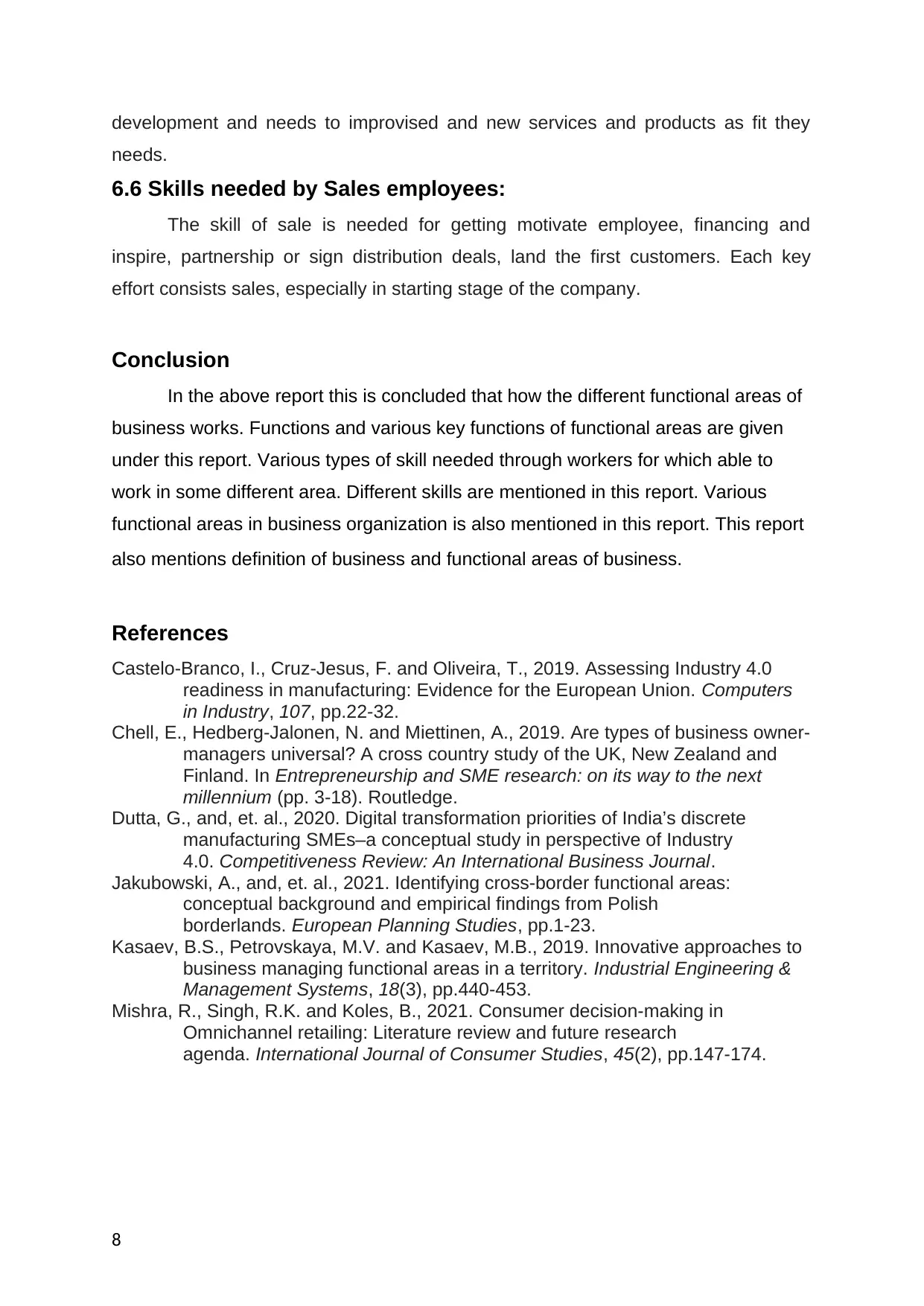
development and needs to improvised and new services and products as fit they
needs.
6.6 Skills needed by Sales employees:
The skill of sale is needed for getting motivate employee, financing and
inspire, partnership or sign distribution deals, land the first customers. Each key
effort consists sales, especially in starting stage of the company.
Conclusion
In the above report this is concluded that how the different functional areas of
business works. Functions and various key functions of functional areas are given
under this report. Various types of skill needed through workers for which able to
work in some different area. Different skills are mentioned in this report. Various
functional areas in business organization is also mentioned in this report. This report
also mentions definition of business and functional areas of business.
References
Castelo-Branco, I., Cruz-Jesus, F. and Oliveira, T., 2019. Assessing Industry 4.0
readiness in manufacturing: Evidence for the European Union. Computers
in Industry, 107, pp.22-32.
Chell, E., Hedberg-Jalonen, N. and Miettinen, A., 2019. Are types of business owner-
managers universal? A cross country study of the UK, New Zealand and
Finland. In Entrepreneurship and SME research: on its way to the next
millennium (pp. 3-18). Routledge.
Dutta, G., and, et. al., 2020. Digital transformation priorities of India’s discrete
manufacturing SMEs–a conceptual study in perspective of Industry
4.0. Competitiveness Review: An International Business Journal.
Jakubowski, A., and, et. al., 2021. Identifying cross-border functional areas:
conceptual background and empirical findings from Polish
borderlands. European Planning Studies, pp.1-23.
Kasaev, B.S., Petrovskaya, M.V. and Kasaev, M.B., 2019. Innovative approaches to
business managing functional areas in a territory. Industrial Engineering &
Management Systems, 18(3), pp.440-453.
Mishra, R., Singh, R.K. and Koles, B., 2021. Consumer decision‐making in
Omnichannel retailing: Literature review and future research
agenda. International Journal of Consumer Studies, 45(2), pp.147-174.
8
needs.
6.6 Skills needed by Sales employees:
The skill of sale is needed for getting motivate employee, financing and
inspire, partnership or sign distribution deals, land the first customers. Each key
effort consists sales, especially in starting stage of the company.
Conclusion
In the above report this is concluded that how the different functional areas of
business works. Functions and various key functions of functional areas are given
under this report. Various types of skill needed through workers for which able to
work in some different area. Different skills are mentioned in this report. Various
functional areas in business organization is also mentioned in this report. This report
also mentions definition of business and functional areas of business.
References
Castelo-Branco, I., Cruz-Jesus, F. and Oliveira, T., 2019. Assessing Industry 4.0
readiness in manufacturing: Evidence for the European Union. Computers
in Industry, 107, pp.22-32.
Chell, E., Hedberg-Jalonen, N. and Miettinen, A., 2019. Are types of business owner-
managers universal? A cross country study of the UK, New Zealand and
Finland. In Entrepreneurship and SME research: on its way to the next
millennium (pp. 3-18). Routledge.
Dutta, G., and, et. al., 2020. Digital transformation priorities of India’s discrete
manufacturing SMEs–a conceptual study in perspective of Industry
4.0. Competitiveness Review: An International Business Journal.
Jakubowski, A., and, et. al., 2021. Identifying cross-border functional areas:
conceptual background and empirical findings from Polish
borderlands. European Planning Studies, pp.1-23.
Kasaev, B.S., Petrovskaya, M.V. and Kasaev, M.B., 2019. Innovative approaches to
business managing functional areas in a territory. Industrial Engineering &
Management Systems, 18(3), pp.440-453.
Mishra, R., Singh, R.K. and Koles, B., 2021. Consumer decision‐making in
Omnichannel retailing: Literature review and future research
agenda. International Journal of Consumer Studies, 45(2), pp.147-174.
8
1 out of 8
Related Documents
Your All-in-One AI-Powered Toolkit for Academic Success.
+13062052269
info@desklib.com
Available 24*7 on WhatsApp / Email
![[object Object]](/_next/static/media/star-bottom.7253800d.svg)
Unlock your academic potential
Copyright © 2020–2025 A2Z Services. All Rights Reserved. Developed and managed by ZUCOL.



